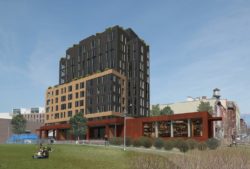Zoning Subcommittee heard testimony on proposed eleven-story tower to abut WNYC Transmitter Park in Brooklyn’s Greenpoint neighborhood. On May 16, 2017, the City Council’s Zoning Subcommittee heard testimony regarding an application submitted by Kent/Greenpoint, LLC, to develop an eleven-story mixed-use building in Brooklyn’s Greenpoint neighborhood. The applicant sought to amend bulk regulations related to the location of legal windows, landscaping requirements for off-street parking and minimum street wall heights in order to orientate the massing of the proposed building towards Transmitter Park.
The site is currently occupied by five one- and two-story warehouses and abuts WNYC Transmitter Park, a 6.6 acre public park opened in 2012. The proposed building would contain 66,800 square feet of floor area, about 77 dwelling units, 4,300 square feet of ground floor retail and 36 off-street parking spots.
Both Brooklyn Community Board 1 and the Borough President recommended approval of the application. The organization Friends of Transmitter Park opposed the project, and demanded changes be made so the building would not turn the park into its front yard. The organization also sought contributions to the park to improve facilities.
The City Planning Commission found the application to be appropriate, noting that under current zoning regulations a development could directly abut the park with a blank wall and no legal windows. The Commission also stated that the amendment would “enable the development to be a more efficient, single building with a single core and improved urban design.”
At the May 16th hearing, Nick Hockens, from Greenberg Traurig LLP, presented the project to the subcommittee. Hockens explained that the proposed text amendment would not increase allowed floor area, but would allow legal windows to face the park and a different floorplate for the building. Without the amendment, the development would require a backyard in the center of the project site, forcing the creation of two buildings including a 14-story building. About 23 of the 77 total units would have some form of income restriction. Around seven of the units would be for households earning 80 percent of the area median income, and sixteen units would be for “workforce” households earning 130 percent of the area median income.
Hockens, responding to community concerns, highlighted that without the zoning change the building would be directly next to the park boundary line. With the zoning change the building would be set back over 35 feet back and would include a dense shrubbery line to designate the boundary line. Hockens also told the subcommittee that they were in talks with the Parks Department on how to structure payments for the upkeep of the park.
Chair Donovan Richards asked for more information on the affordable housing. Hockens explained that the MIH bonus requires that seven-and-a-half percent of the floor area be affordable. The project is also using the newly revived 421-a tax exemption which requires 30 percent of the floor area to be for “workforce” at 130 percent AMI. In response to Chair Richards’ question about city affordability programs, Hockens stated they were not planning on pursuing any other affordability program.
Council Member Stephen Levin, speaking to community concerns, reiterated that the new layout blurs the line between the public and private space, whereas the as-of-right scenario seemed to create a more clear line. Hockens explained that the 35-foot setback helped create a buffer and the residential entrance was moved to be 45-feet away from the park. The dense planting area also adds to the break.
Several members of the public testified against the project, including representatives from the Friends of Transmitter Park and the Brooklyn Open Space Alliance. Concerns raised focused on huge gains for the developer with park facing properties and losses to residents with a tower with possible noisy restaurants, stores and expensive apartments invading public space. Speakers were critical of the plant barrier not being sufficient to muffle noises in the park. No one from the public testified in favor of the project.
Council Member Greenfield stressed that this was not a situation where the City Council had much control over the development and its final result. Greenfield pointed out that if the Council voted no, a comparable as-of-right development could be constructed on the site regardless.
Levin ended the hearing highlighting the negative repercussions of the 2005 rezoning. The site went from a manufacturing district to a residential zoning district with excessive development rights. Levin promised to keep the conversation open in hopes of reaching an amicable agreement between community and developer.
The matter was laid over consideration by the subcommittee.
CC: 13–15 Green Point Avenue, Brooklyn (LU 0635-2017) (May 16, 2017).
By: Jonathon Sizemore (Jonathon is the CityLaw Fellow and a New York Law School Graduate, Class of 2016).



